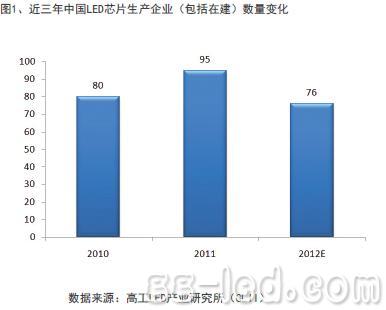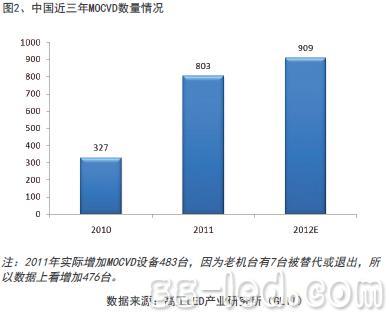[Source: "High - tech LED - Research and Review " November issue GLII]
2012 is the most difficult year for China's LED chip industry. The overcapacity of production capacity and the continued decline in prices remain the main style of the industry.
For most chip companies, revenues have declined year-on-year. In order to seize market share, some companies with strong financial strength will not hesitate to adopt a strategy of low-cost impulse or credit sales.
The decline in prices has led to a decline in corporate profitability, and most companies are already at a loss. Cruel market competition has led to the withdrawal of some chip projects or shelved indefinitely.
Two chip projects have been withdrawn
The statistics of the High-tech LED Industry Research Institute (GLII) show that in 2011, there were 95 LED chip manufacturers in China (including under construction, the same below). As of the end of November 2012, 21 of the new projects have not made any progress since the project was initiated, and have basically been identified as exiting the industry.
Since 2010, the domestic LED chip industry has set off an investment frenzy. In 2010 alone, 20 epitaxial chip projects were established. In 2011, the investment boom continued, with a total of 15 new epitaxial chip projects. Since 2012, there are only two newly established epitaxial chip projects, namely, Suzhou Zhangjiagang Expansion Project of Huacan Optoelectronics and Xi'an Shenguang Haorui Optoelectronics Project.
The change in the number of new projects mentioned above shows that the investment fever of LED epitaxial chips has basically retreated. At the same time, due to the increasingly fierce market competition, the M&A boom is coming.
At present, the LED chip production capacity is seriously over-supplied, the market competition is increasingly fierce, the price is declining, and corporate profits are continuously compressed. In 2012, most domestic epitaxial chip companies were in a state of loss. At present, the LED chip industry is not only a technology, but also a fund. Some enterprises have fought a price war in the market because of the huge subsidy from the government.
GLII expects that the polarization of chip market share will become more and more obvious in the future. The cruel market competition environment will lead more and more chip companies to opt out or be merged. In the future, there will be only 10 LED chip companies in China.
Capacity utilization is only 30%


According to GLII data, as of the end of November 2012, the number of domestic mass production MOCVD equipment was 909, of which 106 were newly added this year, only 1/5 of the number added last year. At the same time, the new machines added this year are mostly orders signed in the past few years, and now they have basically arrived. It is expected that no new machines will enter the mainland in December.

VESA (physical installation interface for Video Electronics Standards Association flat panel display) mounting holes are reserved on the back. Through VESA, a variety of mounting methods such as wall mounts, brackets, and swing arms can be formed. The front panel meets NEMA / IP65 waterproof and dustproof standards, preventing installation in When the control cabinet is splashed with water droplets and steam entering the host, it affects the operation of the equipment; The high-strength all-steel box structure makes it suitable for the harsh working environment of industrial sites, and is most suitable for factory automation, machinery manufacturing, numerical control equipment, Textile equipment, communication network, electric power automation and other industrial occasions.
Wall Mount Vesa Monitor,Wall Mounted Touch Screen,Wall Mounted Touch Screen Display,Wall Mount Touch Screen Monitor
Shenzhen Hengstar Technology Co., Ltd. , https://www.angeltondal.com
